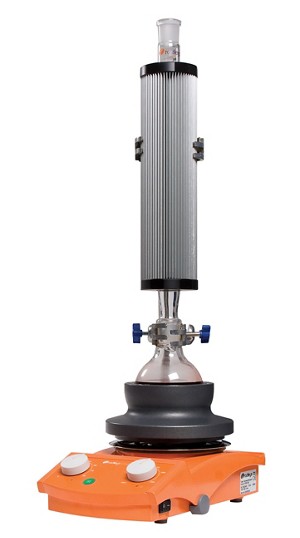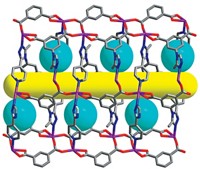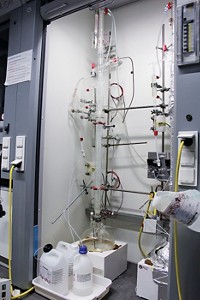Advertisement
Grab your lab coat. Let's get started
Welcome!
Welcome!
Create an account below to get 6 C&EN articles per month, receive newsletters and more - all free.
It seems this is your first time logging in online. Please enter the following information to continue.
As an ACS member you automatically get access to this site. All we need is few more details to create your reading experience.
Not you? Sign in with a different account.
Not you? Sign in with a different account.
ERROR 1
ERROR 1
ERROR 2
ERROR 2
ERROR 2
ERROR 2
ERROR 2
Password and Confirm password must match.
If you have an ACS member number, please enter it here so we can link this account to your membership. (optional)
ERROR 2
ACS values your privacy. By submitting your information, you are gaining access to C&EN and subscribing to our weekly newsletter. We use the information you provide to make your reading experience better, and we will never sell your data to third party members.
Materials
New Condensers Cool Solvent Without Flowing Water
Sustainable Chemistry: Chemists modify glassware to save water while running common reactions
by Leigh Krietsch Boerner
September 26, 2013

In a single reaction, synthetic chemists sometimes can run through hundreds of liters of water, possibly without realizing it. The culprit is their solvent condenser, a piece of glassware that uses flowing water to cool solvents refluxing in a reaction vessel. Now two groups of chemists have invented condensers that use little or no water to condense boiling solvents.

A typical condenser consists of a glass tube nested within another. Water flows between these two tubes. A chemist attaches the condenser to the top of a flask so that as refluxing solvent evaporates and travels up through the center tube, the flowing water cools the solvent. It then condenses on the glass surface and drips back into the flask. Depending on the flow rate, a typical condenser uses 1 to 4 L of water per minute, says Dave Perkins, a senior research scientist at AstraZeneca, in the U.K., and an inventor of one of the new condensers.
Some condensers don’t use running water, such as the air-cooled Vigreux condenser and Sigma-Aldrich’s Airflux, which relies on a small amount of static water. But these pieces of equipment work only with solvents that boil at about 60° C or higher.
Perkins and his coworkers wanted to make the Vigreux condenser work with lower boiling point solvents. To do so, they wrap the glassware with an aluminum sheath decorated with 21-mm-thick fins. The inner part of this aluminum jacket is filled with water. The fins increase the surface area of the condenser and allow it to dissipate heat from the solvent.
In trials, their apparatus retained more solvent than both the Airflux and the traditional Vigreux condensers. When the researchers heated 500 mL of dichloromethane at 60° C—about 20° C above its boiling point—for 16 hours, no solvent was left in the setup using a Vigreux column, but their prototype lost only half the dichloromethane (ACS Sustainable Chem. Eng. 2013, DOI: 10.1021/sc400254c). AstraZeneca has since sold the design to Radleys, a British chemical equipment supplier that developed the prototype.
Anne M. Wilson, an organometallic chemist from Butler University, and colleagues at Dow AgroSciences, took a different approach. They improved upon a standard, water-cooled Allihn condenser, whose inner glass tube consists of a series of connected bulbs to improve solvent condensation. Instead of flowing water, they turned to a different, well-known coolant: ethylene glycol. The coolant has a high heat capacity and is cheap and abundant, Wilson says. The team asked the company ChemGlass to plug the water inlet and modify the upper port on the traditional Allihn condenser to allow them to fill it with ethylene glycol. Unlike in a traditional Allihn condenser, the coolant in this one is static and doesn’t flow through the condenser.
When they refluxed 10 mL of dichloromethane for 18 hours, the new condenser lost about half the solvent. A Vigreux condenser lost all the solvent, and a standard Allihn condenser lost about 42% (ACS Sustainable Chem. Eng. 2013, DOI: 10.1021/sc400285y).
Before reading these papers, Kenneth M. Doxsee, an organometallic chemist at the University of Oregon, didn’t appreciate the amount of water wasted by water-cooled condensers. And air-cooled condensers are not really practical alternatives, he says. “I can probably count on one finger how many times I’ve used a condenser and haven’t used cooling water,” he says.
In addition to saving water, these types of condensers may be useful for labs in countries where there isn’t a readily available water supply, Doxsee says. It would also be interesting to see if these condensers can be scaled up for industrial chemical synthesis, he says.




Join the conversation
Contact the reporter
Submit a Letter to the Editor for publication
Engage with us on Twitter